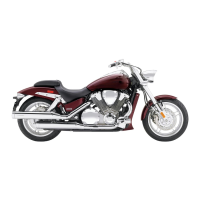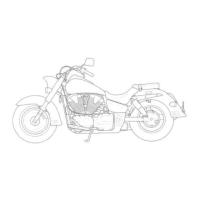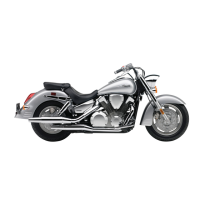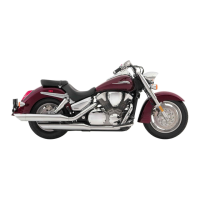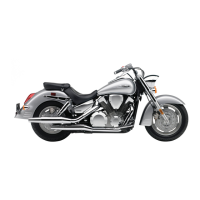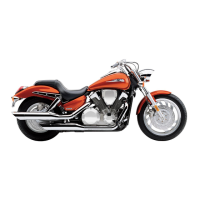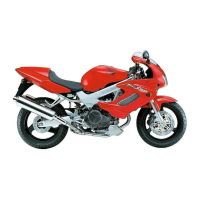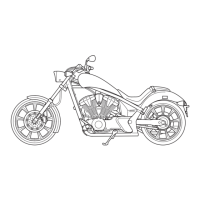Do you have a question about the Honda VTX1800C and is the answer not in the manual?
Motorcycle is designed for operator and one passenger. Never exceed maximum weight capacity.
This motorcycle is designed to be used only on the road.
Pay special attention to safety messages; manual is permanent part of motorcycle.
Important safety information in various forms, including safety alert symbols and signal words.
Preceded by a safety alert symbol and signal words: DANGER, WARNING, or CAUTION.
You WILL be KILLED or SERIOUSLY HURT if you don't follow instructions.
You CAN be KILLED or SERIOUSLY HURT if you don't follow instructions.
You CAN be HURT if you don't follow instructions.
Important safety reminders or precautions, such as Motorcycle Safety.
How to use this motorcycle correctly and safely.
Never exceed personal abilities or faster/dangerous conditions.
Recommendations for approved motorcycle helmet, eye protection, boots, gloves.
How much weight you put on your motorcycle and how you load it is important for safety.
Specifies the maximum weight the motorcycle can carry.
Specifies the maximum weight for cargo.
Motorcycle is intended for rider and passenger; secure items when not riding with passenger.
Adjusting rear shock absorber positions for different riding conditions.
Checking front brake fluid level against marks.
Checking rear brake fluid level against marks.
Checking the clutch fluid level against the lower mark.
Recommends using high-quality ethylene glycol antifreeze.
Checking coolant level in the reserve tank and adding coolant.
Details fuel tank capacity and procedure for opening fuel fill cap.
Recommends unleaded petrol; warns against leaded petrol damaging catalytic converter.
Procedure for starting the engine.
Importance of taking a few moments for pre-ride checks.
Steps to take before starting, including checking indicators.
Steps for starting a fuel-injected engine.
Steps to take if the engine fails to start after repeated attempts.
Advice for the first 500 km to ensure reliability and performance.
Review of motorcycle safety sections before riding.
Ensuring sure the motorcycle is ready for riding.
How the front and rear brake systems operate.
Procedures for normal braking and downshifting.
Why regular maintenance is crucial for safety and performance.
Following the maintenance schedule for proper care.
Safety measures when performing maintenance tasks.
Performing pre-ride inspection and scheduled maintenance.
Understanding I, R, C codes for maintenance tasks.
Recommendations for engine oil quality and API service classification.
Guide to selecting proper engine oil viscosity based on temperature.
Importance of changing oil and filter for engine life.
Steps for draining engine oil.
Procedure for replacing the oil filter.
Spark plug inspection and replacement advice.
Correct procedure for tightening spark plugs.
Steps for changing the final drive oil.
Motorcycle is designed for operator and one passenger. Never exceed maximum weight capacity.
This motorcycle is designed to be used only on the road.
Pay special attention to safety messages; manual is permanent part of motorcycle.
Important safety information in various forms, including safety alert symbols and signal words.
Preceded by a safety alert symbol and signal words: DANGER, WARNING, or CAUTION.
You WILL be KILLED or SERIOUSLY HURT if you don't follow instructions.
You CAN be KILLED or SERIOUSLY HURT if you don't follow instructions.
You CAN be HURT if you don't follow instructions.
Important safety reminders or precautions, such as Motorcycle Safety.
How to use this motorcycle correctly and safely.
Never exceed personal abilities or faster/dangerous conditions.
Recommendations for approved motorcycle helmet, eye protection, boots, gloves.
How much weight you put on your motorcycle and how you load it is important for safety.
Specifies the maximum weight the motorcycle can carry.
Specifies the maximum weight for cargo.
Motorcycle is intended for rider and passenger; secure items when not riding with passenger.
Adjusting rear shock absorber positions for different riding conditions.
Checking front brake fluid level against marks.
Checking rear brake fluid level against marks.
Checking the clutch fluid level against the lower mark.
Recommends using high-quality ethylene glycol antifreeze.
Checking coolant level in the reserve tank and adding coolant.
Details fuel tank capacity and procedure for opening fuel fill cap.
Recommends unleaded petrol; warns against leaded petrol damaging catalytic converter.
Procedure for starting the engine.
Importance of taking a few moments for pre-ride checks.
Steps to take before starting, including checking indicators.
Steps for starting a fuel-injected engine.
Steps to take if the engine fails to start after repeated attempts.
Advice for the first 500 km to ensure reliability and performance.
Review of motorcycle safety sections before riding.
Ensuring sure the motorcycle is ready for riding.
How the front and rear brake systems operate.
Procedures for normal braking and downshifting.
Why regular maintenance is crucial for safety and performance.
Following the maintenance schedule for proper care.
Safety measures when performing maintenance tasks.
Performing pre-ride inspection and scheduled maintenance.
Understanding I, R, C codes for maintenance tasks.
Recommendations for engine oil quality and API service classification.
Guide to selecting proper engine oil viscosity based on temperature.
Importance of changing oil and filter for engine life.
Steps for draining engine oil.
Procedure for replacing the oil filter.
Spark plug inspection and replacement advice.
Correct procedure for tightening spark plugs.
Steps for changing the final drive oil.
| Bore x Stroke | 101.0mm x 112.0mm |
|---|---|
| Compression Ratio | 9.0:1 |
| Transmission | 5-speed |
| Final Drive | Shaft |
| Front Suspension | 45mm inverted fork; 5.1 inches travel |
| Rear Suspension | Dual shocks with five-position spring preload adjustability; 3.9 inches travel |
| Front Tire | 130/70R-18 |
| Rear Tire | 180/70R-16 |
| Wheelbase | 67.5 inches |
| Engine Type | 1795cc liquid-cooled 52° V-twin |
| Fuel System | Programmed Fuel Injection (PGM-FI) |
| Ignition | Digital with three-dimensional mapping |
| Front Brakes | Dual 296mm discs with three-piston calipers |
| Rear Brakes | Single 316mm disc with three-piston caliper |
| Fuel Capacity | 5.3 gallons |



